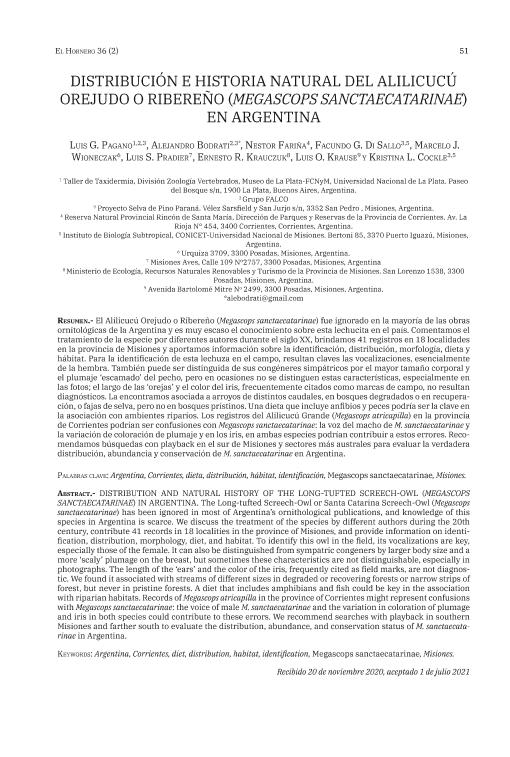Artículo
El Alilicucú Orejudo o Ribereño (Megascops sanctaecatarinae) fue ignorado en la mayoría de las obras ornitológicas de la Argentina y es muy escaso el conocimiento sobre esta lechucita en el país. Comentamos el tratamiento de la especie por diferentes autores durante el siglo XX, brindamos 41 registros en 18 localidades en la provincia de Misiones y aportamos información sobre la identificación, distribución, morfología, dieta y hábitat. Para la identificación de esta lechuza en el campo, resultan claves las vocalizaciones, esencialmente de la hembra. También puede ser distinguida de sus congéneres simpátricos por el mayor tamaño corporal y el plumaje ´escamado´ del pecho, pero en ocasiones no se distinguen estas características, especialmente en las fotos; el largo de las ´orejas´ y el color del iris, frecuentemente citados como marcas de campo, no resultan diagnósticos. La encontramos asociada a arroyos de distintos caudales, en bosques degradados o en recuperación, o fajas de selva, no en bosques prístinos. Una dieta que incluye anfibios y peces podría ser la clave en la asociación con ambientes riparios. Los registros del Alilicucú Grande (Megascops atricapilla) en la provincia de Corrientes podrían ser confusiones con Megascops sanctaecatarinae: la voz del macho de M. sanctaecatarinae y la variación de coloración de plumaje y en los iris, en ambas especies podrían contribuir a estos errores. Recomendamos búsquedas con playback en el sur de Misiones y sectores más australes para evaluar la verdadera distribución, abundancia y conservación de M. sanctaecatarinae en Argentina. The Long-tufted Screech-Owl or Santa Catarina Screech-Owl (Megascops sanctaecatarinae) has been ignored in most of Argentina’s ornithological publications, and knowledge of this species in Argentina is scarce. We discuss the treatment of the species by different authors during the 20th century, contribute 41 records in 18 localities in the province of Misiones, and provide information on identificaron, distribution, morphology, diet, and habitat. To identify this owl in the field, its vocalizations are key, especially those of the female. It can also be distinguished from sympatric congeners by larger body size and a more ‘scaly’ plumage on the breast, but sometimes these characteristics are not distinguishable, especially in photographs. The length of the ‘ears’ and the color of the iris, frequently cited as field marks, are not diagnos-tic. We found it associated with streams of different sizes in degraded or recovering forests or narrow strips of forest, but never in pristine forests. A diet that includes amphibians and fish could be key in the association with riparian habitats. Records of Megascops atricapilla in the province of Corrientes might represent confusions with Megascops sanctaecatarinae: the voice of male M. sanctaecatarinae and the variation in coloration of plumage and iris in both species could contribute to these errors. We recommend searches with playback in southern Misiones and farther south to evaluate the distribution, abundance, and conservation status of M. sanctaecata-rinae in Argentina.
Distribución e historia natural del Alilicucú orejudo o ribereño (megascops sanctaecatarinae) en Argentina
Título:
Distribution and natural history of the long-tufted screech-owl (megascops sanctaecatarinae) in Argentina
Pagano, Luis; Bodrati, Alejandro; Fariña, Nestor; Di Sallo, Facundo Gabriel ; Wioneczak, Marcelo J.; Pradier, Luis S.; Krauczuk, Ernesto R.; Krause, Luis O.; Cockle, Kristina Louise
; Wioneczak, Marcelo J.; Pradier, Luis S.; Krauczuk, Ernesto R.; Krause, Luis O.; Cockle, Kristina Louise
 ; Wioneczak, Marcelo J.; Pradier, Luis S.; Krauczuk, Ernesto R.; Krause, Luis O.; Cockle, Kristina Louise
; Wioneczak, Marcelo J.; Pradier, Luis S.; Krauczuk, Ernesto R.; Krause, Luis O.; Cockle, Kristina Louise
Fecha de publicación:
12/2021
Editorial:
Asociación Ornitológica del Plata
Revista:
El Hornero
ISSN:
0073-3407
e-ISSN:
1850-4884
Idioma:
Español
Tipo de recurso:
Artículo publicado
Clasificación temática:
Resumen
Archivos asociados
Licencia
Identificadores
Colecciones
Articulos(IBS)
Articulos de INSTITUTO DE BIOLOGIA SUBTROPICAL
Articulos de INSTITUTO DE BIOLOGIA SUBTROPICAL
Citación
Pagano, Luis; Bodrati, Alejandro; Fariña, Nestor; Di Sallo, Facundo Gabriel; Wioneczak, Marcelo J.; et al.; Distribución e historia natural del Alilicucú orejudo o ribereño (megascops sanctaecatarinae) en Argentina; Asociación Ornitológica del Plata; El Hornero; 36; 2; 12-2021; 51-64
Compartir



